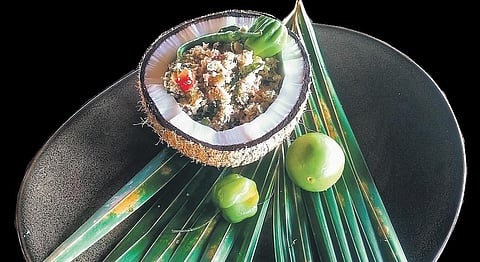

If the average Sri Lankan sambol were to be a person, it would be diagnosed with a multiple personality disorder. Adjectives like spicy, sweet, sour and searing hot—employed singularly, sometimes all at once—are bandied about by those who’ve been fortunate enough to have tasted it. In its various forms—dip, marinade, relish and more commonly as condiment—sambol is the inevitable accompaniment to any veritable Sri Lankan meal.
Said to have been derived from the other Dutch colony of Indonesia’s sambal chilly paste, sambol acquired the ‘o’ when the Dutch introduced it to Sri Lanka. “Once here, it soon was co-opted by the natives, who added locally abundant ingredients like chillies, grated coconut, lime juice and vegetables like nelum ala (lotus stem) and dambala (winged bean),” says K Ravichandran, chef de partie at the Ceylon Tea Trails resort in Hatton. “The idea is to mix the ingredients vigorously together in a traditional, wooden grinding device called a mirisgala to create a spicy side dish that is eaten uncooked,” he adds.
In the ‘up country’, as Sri Lankans refer to hill stations such as Hatton, one can find a few Tamil cuisine-influenced sambols like ash plantain and pumpkin sambols that were brought in by the tea pickers of Tamil origin. Here, other heat-inducing sambols like the hot pepper and kochinai (green chilly) are also popular, especially during winters.
From the trifecta of the most popular pol (coconut) sambol, the fiery hot lunumiris (literally: salt and red chilly) and the mild and sweet, caramelised onion-based seeni (like cheeni or sugar) to a few other regional iterations, there is no dearth of varieties. Interestingly, each has its own ‘parent’ dish.
“For example, seeni sambol and lunumiris are popular accompaniments for hoppers or kiri bath (milk rice) while the leaf-based sambols like gotukola (pennywort), asamodagam (wild celery)—popular in Jaffna up north—are often eaten with rice,” says Amila Shirantha, executive chef at Wild Coast Tented Lodge that’s located in the Yala National Park.
Well-known for melding local flavours with an international sensibility, Gunendra Pushpasiri, executive sous chef at Cape Weligama, gives the sambol a contemporary makeover with his seven-course tasting menu. “While I have reduced a traditionally prepared seeni to a puree and served it piped atop a goat curry and heirloom suwandel rice, I felt that the heat of the lunumiris would be the perfect foil to the delicate flavours of my lobster dumpling in a saffron-seafood broth,” he says.Now, that’s haute cuisine with a ‘hot’ twist.